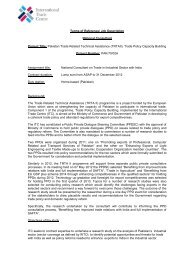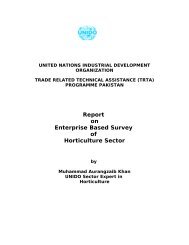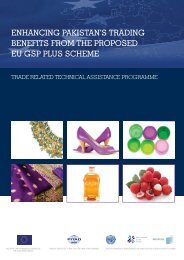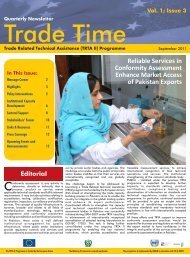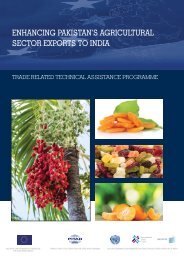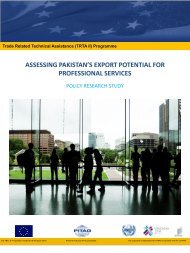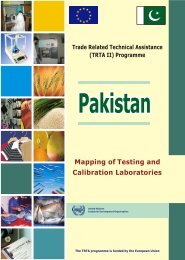Enhancing dairy sector export competitiveness - International Trade ...
Enhancing dairy sector export competitiveness - International Trade ...
Enhancing dairy sector export competitiveness - International Trade ...
Create successful ePaper yourself
Turn your PDF publications into a flip-book with our unique Google optimized e-Paper software.
ENHANCING DAIRY SECTOR EXPORT COMPETITIVENESS IN PAKISTANimprovement. The government has therefore been criticised for not being able to deal with this urgentissue. 103Imported semen doses become very expensive for the private <strong>sector</strong>, ranging from PKR 10,000 to 12,000each. Furthermore, the absence of appropriate domestic regulations has encouraged the production ofsubstandard semen doses by the private <strong>sector</strong>. 104 Artificial Insemination (AI) technicians are insufficient.Due to financial limitations, against a requirement of employing 16,000 trained personnel, only 900 paidemployees and 3,000 self-employed people are presently working in the PLDDB’s programme.There is also a capacity building issue for the stakeholders in semen freezing, artificial insemination andembryo transfer 105 . The Dairy Project under the USAID has been able to train 170 technicians ArtificialInsemination technique with 100% self-employment after successful conclusion of the training. However,the aim is to train 2,000 technicians in this field and establish them as small entrepreneurs by 2014. 106Feed and Nutritional ManagementAlthough the federal and provincial government and the private <strong>sector</strong> as well as the donor agencies havestarted various initiatives on feed and nutrition management for the farmers, the impact of these initiativesstill remains very low. There exist large gaps between the supply of appropriate fodder and its demand inthe country.Veterinary Support and Animal HealthThe absence of an appropriate national policy in veterinary support and animal healthcare has resulted intooverall deterioration of veterinary services in Pakistan. Despite presence of infrastructure for theseservices in the country, there are limitations as to the quality and outreach of service providers in this fieldconsidering the fact that at least 8 million small, medium and large farmers have to be approached.Apart from farmers’ lack of awareness of the importance of veterinary matters and the issues of limitedresources hindering the service providers to reach to such a large number of farmers, a major issueremains that the healthcare staff is not appropriately trained. There is shortage of trained personnel in thisfield also that is yet another barrier on appropriate service delivery to the target group. These are not onlysome major impediments in enhancing livestock production in the country but also restrict <strong>export</strong>opportunities of value added products from Pakistan.RecommendationsBreed Preservation and Management(i)(ii)(iii)There is a general consensus amongst the stakeholders that efforts need to be made on thenational level to preserve the local breeds. 107Up-gradation of the genetic potential of indigenous breeds like Sahiwal Cattle, CholistaniCattle and Nili-Ravi Buffalo 108 needs to be focused on by the government as these have themost superior germplasm. A lack of awareness regarding breed management is the biggestissue that needs to be tackled at the grass roots level to ensure that good bulls are bredthrough appropriate feed and nutrition to produce healthier and superior off-springs. 109 Thisstrategy needs a long-term and continuous planning and implementation to counter thenegative attitudes and lack of responsiveness amongst the local farmers. 110Government projects like the CEDSEB are currently facing financial constraints due to lack ofpublic funds. It is proposed that private <strong>sector</strong> competition as well as joint ventures withinternationally renowned companies should be introduced in the project to ensure its early103 Nestle Pakistan104 Availability of semen doses in Punjab is a big issue. Punjab’s annual requirement of semen doses is 8 million, whereas only 2million doses are produced leaving a deficiency of 75%. (PLDDB)105Punjab Livestock and Dairy Development Board (PLDDB)106 USAID Pakistan, Economic Growth and Agriculture, Dairy Project, http://transition.usaid.gov/pk/db/<strong>sector</strong>s/growth/project_20.html107 Department of Industries, Commerce and Investment, Government of Punjab108 These breeds have the capacity to produce up to 30-40 liters of milk per animal on average during a lactation period109 Punjab Livestock and Dairy Development Board (PLDDB)110 It should be noted that, as discussed above, farming and rearing practices amongst the local farmers are mainly based upontraditional knowledge and experience and therefore a majority of them resist in changing their attitude towards improvement.74



